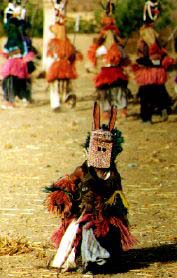
 Saturn and Jupiter |
Extra astronomical
information in Renard Pale
includes the following: (links to astronomical tests)
Page references are for The Pale Fox, translated
by Stephen C Infantino, Continuum Foundation 1986
a) about Sirius:
"Emme ya tolo" has two satellites
named "ara tolo" and "yu tolo" -- pp311-312.
"Ara tolo" has "time of
revolution" of 30 years --
footnote no. 122, p312.
"Nyan tolo" in Un Systeme Soudanais de
Sirius is not present and one must assume it is the
same as "ara tolo."
Emme ya is stated to have an orbit of 50 years,
but "another source" says this may be 32 years -- footnote p506.
b) about other astronomical bodies:
"Now, the term yalu ulo,
designates the Milky Way of our galaxy, which includes
the entire stellar world of which the Earth is part, and
which turns in a spiral."
-- p128
Saturn is the "star of the Milky Way."
-- p314
Saturn has a "halo" represented by a
"bulging urn" -- p314.
Jupiter is represented by a circle surrounded by
its four satellites, placed at the collteral directions,
and called dana tolo unum, "children of dana
tolo [star of the skull]". -- p352
The moon is "dry and lifeless like dried-up
lifeless blood." -- p509
A Venusian calendar is determined by six
observable positions in a year.
-- pp514-518.
A number of other stars are important, mostly
those around Orion, known as Amma's seat. -- map p501.
c) Enigmatic
statement
'The spiral worlds of stars were populated universes;
because, simultaneously with things, Amma, having given
form and movement to the world, created all living beings.
Just as on our own planet, living beings will live on
those other "Earths"...'
(+ Ftnote no. 261)
"This proliferation of life is illustrated by a
commentary on the myth, of explanatory value, inwhich it
is said: people are on the fourth earth, but on the third
there are "people with horns," inneu kelugu,
on the fifth, "people with tails," inneu
dullogu, on the sixth, "winged people,' inneu
gammurugu, on the seventh, "crawling people,"
inneu bummo, etc. This is to emphasize the
absolute ignorance one has of forms of life on other
worlds, but also the certainty of the presence of those
forms." -- p194
